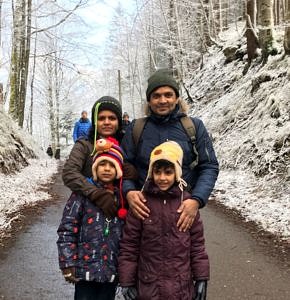Dr. Sandip Shinde
Humboldt Research Fellow and guest researcher at the Clinic of Nuclear Medicine at the Universitätsklinikum Erlangen
Dr. Sandip Shinde’s research interest is in organic synthesis in order to develop fluorination methods and their applications in pharmaceutical and agro-chemical companies. Findings from his PhD research work were transferred and patented to various multinational companies such as the Bayer AG in Germany or the Sogang Technology Commercialization – SGU Holdings Co., Ltd. in South Korea.
Dr. Sandip Shinde was born in Parbhani, India, where he obtained a Master of Science in Organic Chemistry at the Swami Ramanand Teerth Marathwada University, Nanded, India. In 2008, he received a PhD in Organic Chemistry from the Inha University, Inchon, in South Korea. Since 2013, Dr. Shinde holds the position as Assistant Professor (AcSIR) Ramanujan Fellow at the CSIR-National Chemical Laboratory in Pune, India.
Dr. Shinde will further his research at the Clinic of Nuclear Medicine at the Universitätsklinikum Erlangen under the supervision of Prof. Dr. Olaf Prante. His stay is supported by the Alexander von Humboldt Foundation.
FAU has excellent research facilities in the field of radiopharmaceutical sciences (…).
Dr. Shinde, what is your field of research and what exactly sparked your interest in this field?
I do research in the area of synthesis of fluorinated organic molecules. I felt encouraged by the importance of fluorine substituted biomolecules, to understand their mechanistic pathway in the living organism and their application as radiopharmaceuticals for diagnostic imaging of diseases by the use of positron emission tomography (PET). Suitable fluorine-18 radioactive labelled agents for PET, so called tracers, are highly effective for the diagnosis of various diseases in the fields of neurology, cardiology, inflammatory diseases, but mainly in the field of oncology. Contrary to classical CT or MR imaging, the PET technique, together with the use of specific fluorine-18 labelled tracers, is especially suited for sensitive detection of cancer at the beginning stage of the disease, such that we could obtain the opportunity to cure cancer in an early stage.
Since October 2019, you have been working together with Prof. Dr. Prante at the Clinic of Nuclear Medicine. What are you currently researching?
We are doing research to develop efficient, cost-effective and rapid radiolabeling processes with fluorine-18 to facilitate the synthesis of valuable imaging agents for PET.
What do you and Prof. Dr. Prante hope to achieve with your research?
The understanding of how newly developed phase transfer catalysts and solid-phase-supported reactions can improve the yield of fluorine-18 substituted imaging agents. The new findings are to be adapted to processes in the clean room laboratory of the nuclear medicine clinic, where the manufacturing of radiopharmaceuticals for human application is performed. We hope to establish a long-term collaboration in radiopharmaceutical research with FAU after I go back to India.
How could society benefit from your research?
The success of my research will significantly affect the availability of special PET imaging agents, their synthesis costs, and the quality of imaging agents. Since my research results could be directly translated into clinical application at the University Hospital, all patients of the nuclear medicine clinic could benefit from the availability of new radiopharmaceuticals for PET.
Contrary to classical CT or MR imaging, the PET technique, together with the use of specific fluorine-18 labelled tracers, is especially suited for sensitive detection of cancer at the beginning stage of the disease, such that we could obtain the opportunity to cure cancer in an early stage.
What were your reasons for choosing FAU as your host institution?
FAU has excellent research facilities in the field of radiopharmaceutical sciences at the section of Molecular Imaging and Radiochemistry by Prof. Prante as part of the Department of Nuclear Medicine, headed by Prof. Kuwert, with a long-term close collaboration with Prof. Gmeiner, the Chair of Pharmaceutical Chemistry at FAU. I very much noticed their joint research studies and felt that at FAU the disciplines of medicinal chemistry and radiopharmacy are excellently combined and could promote my interdisciplinary research efforts.
What do you think is the greatest thing about your profession as a scientist?
I distinctly remember one day when I was playing a game at school and I was looking against the sun through the palm of my hand. I remember that I tried to differentiate the veins, bones and tissue of my hand. Somehow, this impression to differentiate between body functions is similar to what radiopharmaceuticals could achieve nowadays: The injected radioactive labelled substance emits light (sun) through the body and we can observe the body function through the “eyes” of PET.
New discoveries in a research lab could provide you with knowledge about the physical world and this can train you to think about a higher quality of life. Your knowledge and skill can develop into new inventions that can balance the nature and our life.
What motivates you to continue your research?
Knowledge, training and know-how on radiopharmaceuticals are the key prerequisites for the successful development of new PET imaging agents for better understanding of various diseases that are associated to human life. Precious and accurate understanding of disease mechanisms will be possible and hopefully achieved by advanced and extended research efforts in the field of nuclear medicine.

How do you like Erlangen and the region surrounding it? Is this your first time in Erlangen?
Healthy, beautiful atmosphere and convenient transportation system. Yes, it is the first time in Erlangen for my family and me.
Is there anything else you would like to mention?
Thank you very much for interviewing me! I would like to take this opportunity to say “Thank you” to the FAU Welcome Center! They were helpful both for me and for my family during our initial stay in Germany.
Thank you for the interview, Dr. Shinde.
